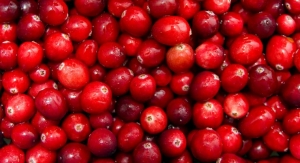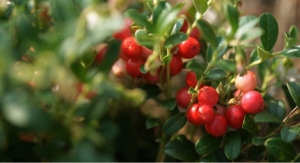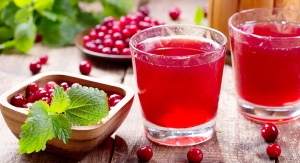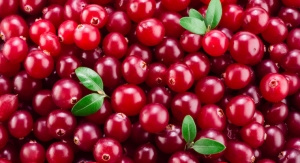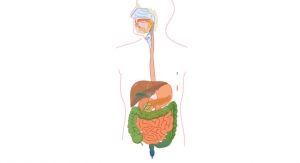04.17.17
Two new studies on Cranberex cranberry extract from Ethical Naturals Inc. (ENI) confirm the anti-adhesion activity and potential therapeutic use.
Cranberex is a highly-concentrated extract standardized to contain 15% of cranberry’s most active constituents: the distinct ‘A-Type’ linkage proanthocyanidins (PAC’s), which don’t occur in PACs from other tannin-rich foods. Measured by the BL-DMAC method, this extract feature connects Cranberex to the latest clinical trials demonstrating cranberry’s ability to support urinary tract health (UTH).
Cranberries affect and support UTH in a notable way: the cranberry A-Type PAC’s inhibit the adhesion of E. coli bacteria to the walls of the urinary tract. Studies have confirmed that this effect is specific to PAC’s found only in cranberry. As this bacterial anti-adhesion mechanism does not kill bacteria, there is less chance of selection for resistant bacterial strains (than when antibiotics are used). This has been considered an advantage compared to antibiotic treatment for UTI’s, and in some cases more effective in reducing the reoccurrence of UTI’s.
Its estimated that there are up to 10.5 million doctor visits for urinary tract infections in the U.S. each year, and probably at least 800,000 are antibiotic resistant. Total costs, including lost work time for patients, are estimated to be $3.5 billion/year in the U.S.
For these reasons, ENI chose to conduct two studies at Rutgers University, using peer-reviewed and published methods, that focused on quantifying the anti-adhesion activity (AAA) of cranberry products. The first of these was an in-vitro study that compared the AAA of Cranberex with nine other samples of cranberry extract (including both raw material and finished products). In this study, Cranberex met the anti-adhesion criteria at a concentration of only 0.23mg/mL. The other key products tested required much higher concentrations to achieve the same anti-adhesion result. The study concluded that Cranberex has excellent anti-adhesion activity.
The second study, conducted with 10 human participants, was designed to test actual anti-adhesion activity in urine samples after consumption of two doses (1 dose in the evening and 1 dose in the morning) of Cranberex at recommended dosage level. The report stated that AAA response increased rapidly in all participants 3-6 hours after consumption of Cranberex. Half of the participants achieved 100% of significant bacterial anti-adhesion activity, while half achieved 50%, resulting in an average of 75% AAA.
“We’re very pleased with the results of these studies,” said Cal Bewicke, CEO of ENI. “Working with premium cranberries from the Oregon coast, and with the precise DMAC method of analysis, we are able to produce an extract that corresponds to the gold standard in cranberry research. These two studies confirm the activity of Cranberex, and further open the door to the therapeutic use of high-grade cranberry extracts.”
Cranberex is a highly-concentrated extract standardized to contain 15% of cranberry’s most active constituents: the distinct ‘A-Type’ linkage proanthocyanidins (PAC’s), which don’t occur in PACs from other tannin-rich foods. Measured by the BL-DMAC method, this extract feature connects Cranberex to the latest clinical trials demonstrating cranberry’s ability to support urinary tract health (UTH).
Cranberries affect and support UTH in a notable way: the cranberry A-Type PAC’s inhibit the adhesion of E. coli bacteria to the walls of the urinary tract. Studies have confirmed that this effect is specific to PAC’s found only in cranberry. As this bacterial anti-adhesion mechanism does not kill bacteria, there is less chance of selection for resistant bacterial strains (than when antibiotics are used). This has been considered an advantage compared to antibiotic treatment for UTI’s, and in some cases more effective in reducing the reoccurrence of UTI’s.
Its estimated that there are up to 10.5 million doctor visits for urinary tract infections in the U.S. each year, and probably at least 800,000 are antibiotic resistant. Total costs, including lost work time for patients, are estimated to be $3.5 billion/year in the U.S.
For these reasons, ENI chose to conduct two studies at Rutgers University, using peer-reviewed and published methods, that focused on quantifying the anti-adhesion activity (AAA) of cranberry products. The first of these was an in-vitro study that compared the AAA of Cranberex with nine other samples of cranberry extract (including both raw material and finished products). In this study, Cranberex met the anti-adhesion criteria at a concentration of only 0.23mg/mL. The other key products tested required much higher concentrations to achieve the same anti-adhesion result. The study concluded that Cranberex has excellent anti-adhesion activity.
The second study, conducted with 10 human participants, was designed to test actual anti-adhesion activity in urine samples after consumption of two doses (1 dose in the evening and 1 dose in the morning) of Cranberex at recommended dosage level. The report stated that AAA response increased rapidly in all participants 3-6 hours after consumption of Cranberex. Half of the participants achieved 100% of significant bacterial anti-adhesion activity, while half achieved 50%, resulting in an average of 75% AAA.
“We’re very pleased with the results of these studies,” said Cal Bewicke, CEO of ENI. “Working with premium cranberries from the Oregon coast, and with the precise DMAC method of analysis, we are able to produce an extract that corresponds to the gold standard in cranberry research. These two studies confirm the activity of Cranberex, and further open the door to the therapeutic use of high-grade cranberry extracts.”


